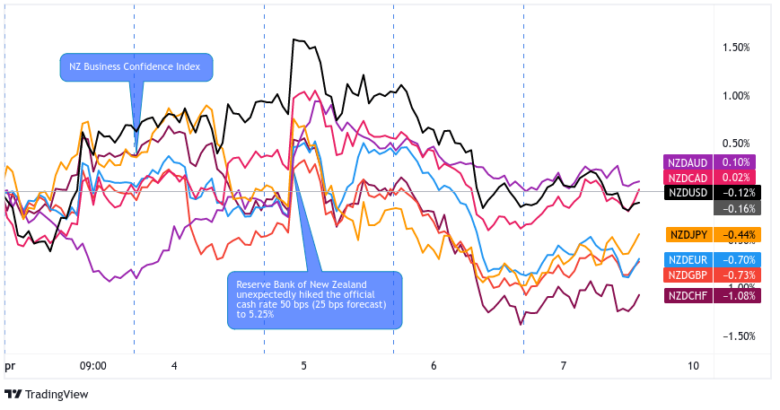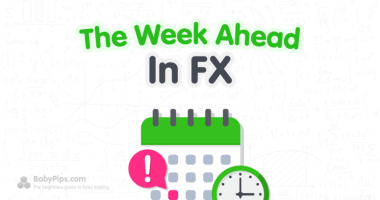Looking for another top-tier catalyst to trade?
You might wanna start prepping for the Reserve Bank of New Zealand (RBNZ) policy decision next week!
Here are points to note if you’re planning on trading NZD during the release:
Events in Focus:
Reserve Bank of New Zealand Monetary Policy Statement
When Will it Be Released:
July 12, Wednesday: 2:00 am GMT
Use our Forex Market Hours tool to convert GMT to your local time zone.
Expectations:
- RBNZ is likely to keep interest rates on hold at 5.50%
- RBNZ policymakers are expected to signal willingness to resume hiking if inflation picks up again
Relevant New Zealand Data Since the Last RBNZ Statement:
? Arguments for Tighter Monetary Policy / Potentially Bullish for NZD
ANZ business confidence index improved from -43.8 to -31.1 in May, followed by another climb to -18.0 in June
Westpac consumer confidence index climbed from 77.7 to 83.1 in Q2 but still indicative of pessimism due to financial pressures on households
BusinessNZ services index rose from 50.1 to 53.3 in May to reflect a stronger pace of expansion due to higher new orders and stocks
BusinessNZ manufacturing index climbed from 48.8 to 48.9 in May, signaling a slightly slower pace of contraction in the industry
? Arguments for Looser Monetary Policy / Potentially Bearish for NZD
Q2 GDP confirmed a technical recession for New Zealand, as the economy contracted 0.1% while the previous quarter’s figure was downgraded to show a 0.7% drop in growth
ANZ commodity prices posted a meager 0.3% month-over-month uptick in May, followed by a 2.3% slump in June due to lower meat and log costs
GDT price index has been posting declines in dairy prices (dairy is one of New Zealand’s largest export product) since mid-May, with a -3.3% slump in the latest auction
Previous Releases and Risk Environment Influence on NZD
May 24, 2023
Action/results:
The RBNZ increased the OCR by 0.25% as expected, but this was mostly seen as a dovish hike since policymakers hinted that interest rates may have peaked.
They even revealed that the committee had a split vote on the decision since some wanted to sit on their hands on account of subsiding inflationary pressures and weaker business conditions on the domestic front.
Not surprisingly, this spurred another leg lower for the Kiwi – which was already on the decline following the downbeat quarterly retail sales released the day prior – that lasted for the rest of the week.
Risk Environment and Intermarket Behaviors:
This trading week was characterized by relatively low volatility, as market players had been holding out for more updates on the U.S. debt ceiling impasse.
Risk-off vibes returned to the markets on Monday when news broke out that debt ceiling negotiations broke down over the weekend, keeping higher-yielders on the back foot.
Concerns about China’s economic rebound and commodity demand weighed on risk assets midweek as well. To top it off, hawkish rhetoric from the FOMC minutes also kept investors wary of recession risks.
It wasn’t until the end of the week that risk appetite picked up, but the Kiwi was barely able to hold on to its intraday gains then.
Apr. 5, 2023

Overlay of NZD vs. Major FX Chart by TV
Action/results:
The April RBNZ decision was one of the more hawkish ones, as the central bank surprised with a 0.50% hike instead of the expected 0.25% increase.
In addition, policymakers reiterated their hawkish bias by citing that inflation remains too high and persistent. They even added that employment remains “beyond its maximum sustainable level” and that the financial system is stable enough.
After a bit of a rangebound start to the week, the upbeat RBNZ announcement boosted the Kiwi to fresh highs against its peers. However, the commodity currency soon returned these gains (and then some) throughout the latter half of the week since there were no other catalysts to sustain the rallies.
Risk Environment and Intermarket Behaviors:
Traders seemed keen on booking their profits off the big market moves during this shortened trading week, as many were about to take off early for the Easter holidays.
To top it off, a few downbeat PMI readings from the major economies also revived global recession fears and pulled riskier currencies back down.
Price action probabilities
Risk sentiment probabilities: The RBNZ decision on Wednesday comes after the release of China’s latest round of inflation figures, which may set the tone for overall market sentiment for the week.
So far, the dominant theme among most major economies is that of stubborn price pressures spurring the need for hawkish monetary policy. In turn, the prospect of higher borrowing costs appears to be keeping a lid on risk rallies, something clearly seen today after the U.S. printed strong jobs numbers, which fuels rate hike speculation.
With that, strong Chinese CPI readings next may dash hopes for PBOC stimulus, which could then translate to risk-off flows early on. Later on Tuesday, the U.S. will release its own set of CPI and PPI data, likely influencing sentiment for the rest of the week.
New Zealand Dollar scenarios
Base case: The latest round of economic data from New Zealand points to some feeble improvements in business and consumer sentiment, which is likely not enough to encourage RBNZ policymakers to hike interest rates again.
Consistently declining price pressures, as shown by the ANZ commodity price index and the GDT auctions, would likely be enough reason for policymakers to reiterate that they’re likely to stand pat for much longer.
Since this scenario has been priced in for quite some time, the Kiwi might have a limited reaction to the actual announcement if we do see a rate hold. And based on the broad recovery in the Kiwi against the majors since the end of June, it’s possible that some traders may lighten up on Kiwi longs (i.e., profit taking), especially if there are signs that the hawkish tone is dialed down further at this meeting. Fresh longs tend to be limited after a rally as well.
If risk-off flows are in play during the decision, look out for opportunities to short NZD against lower-yielders / safe havens like JPY, CHF and USD.
Alternative Scenario: With some major economies like the U.K., Australia, and Canada staying on the lookout for sticky inflation, RBNZ officials might also entertain and signal the possibility of resuming rate hikes later in the year.
In this case, the Kiwi may attract buyers, both fundie and technical traders, especially against currencies with central banks sticking to a dovish stance like the yen. If risk-on flows return, then long opportunities make sense against CHF and USD (if anti-dollar sentiment rises next week around U.S. inflation updates).
In either of the scenarios above, the least risky price strategy ideas will likely be based on the idea of waiting to see the risk environment around the RBNZ decision and what the RBNZ actually says in both the statement and press conference.
In other words, being patient may be the better strategy than anticipating a certain outcome at this time, but of course, risk management is up to each individual trader’s trading style, risk tolerance and capital circumstances.









